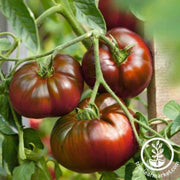Out Of Stock!
We will notify you when this product becomes available.
Tomato Seeds - Slicing - Paul Robeson
74 Days to maturity (from transplant). Solanum lycopersicum. Paul Robeson Tomato Seeds. Non-GMO, warm season annual, open-pollinated, heirloom, indeterminate, slicing tomato. Suitable for growing in garden plots, raised beds, greenhouses, and containers. Resistant to Disorders. Russian heirloom indeterminate round 4 in. slightly flattened fruit with brown to dusky dark red skin. ~ 6,800 seeds/ounce.




Download Free Vegetable Growing Guide PDF
Growing Paul Robeson Slicer Tomatoes in the Vegetable Garden
To start, select high-quality tomato seeds and initiate the indoor seeding process 7-9 weeks before the last expected frost. Using a well-draining seed-starting mix and planting seeds at an appropriate depth is crucial. Adequate light, either from natural sunlight or artificial sources, is essential for healthy seedling development. Rotation of seed trays helps prevent seedlings from leaning towards the light.
As the seedlings grow to around 2 inches and develop true leaves, the American Horticultural Society advises transplanting them into larger containers with nutrient-rich potting soil. This step fosters robust root development, a key factor in plant health. For those with limited space, growing tomatoes in containers is suggested, with large containers and proper drainage being essential. After transplanting it is continually important to provide proper drainage and full sun.
Conduct a soil test before planting outdoors to ensure optimal conditions for tomato growth. Tomatoes prefer slightly acidic soil with a pH range of 6.0-6.8. Experts recommend crop rotation to prevent soil-borne diseases, and they discourage planting tomatoes in the same location as the previous year. Tomatoes require a minimum of 6-8 hours of direct sunlight daily. Positioning plants near a south-facing window or supplementing with artificial grow lights is advised for indoor cultivation.
Throughout the growing process, careful monitoring and adjustments based on plant needs are encouraged. It is critical to have consistent watering, avoiding waterlogged conditions, and regular fertilization with a balanced fertilizer. Maintaining optimal temperature and humidity conditions is essential, especially during the germination and seedling stages. Tomatoes thrive in warm temperatures, ideally between 70-85°F (21-29°C) during the day and not dropping below 50°F (10°C) at night. Provide consistent warmth for germination, and once seedlings emerge, ensure a gradual transition to outdoor conditions. Keep humidity levels around 70-75% for germination, decreasing to 50-60% for seedling growth. Adequate air circulation minimizes humidity-related issues. Proper ventilation and spacing between plants, along with regular monitoring for signs of stress, contribute to a healthy tomato crop.
Vigilance against pests and diseases is essential, with organic remedies or pesticides recommended when necessary. Identifying and addressing potential issues in tomato plants is crucial for a successful harvest. Common pests affecting tomatoes include aphids, hornworms, and fungal diseases like early and late blight. Keep a watchful eye for yellowing leaves, distorted growth, or spots on leaves, as these can be signs of problems. Aphids can be controlled with a strong spray of water or insecticidal soap, while hornworms can be handpicked. Fungal diseases may require fungicidal treatments or removing affected foliage promptly to prevent spreading.
Harvesting Paul Robeson Tomatoes
Harvesting indeterminate tomatoes is an ongoing and rewarding process. Monitor the plants regularly for ripeness, as these tomatoes continue to produce fruit throughout the growing season. Indicators of ripeness include a vibrant red color and a slight softness when gently pressed. Harvest individual tomatoes as they reach maturity by twisting or cutting them from the vine, leaving a small portion of the stem attached.
About Heirloom Paul Robeson Tomato Garden Seeds
Indeterminate tomatoes continue to grow and produce fruit throughout the season, offering a prolonged harvest. Unlike determinate varieties that set fruit all at once, indeterminate tomatoes provide a steady supply, favoring them by gardeners seeking a continuous yield for fresh consumption or preservation.
This Russian heirloom indeterminate tomato plant produces fruits that are round and 4 inches in diameter. Slightly flattened fruit with brown to dusky dark red skin has a brown center, dark green shoulders and an earthy flavor. The original seed is from Marina Danilenko, a Moscow seedsman. The variety is named after Paul Robeson who was an operatic vocal artist who was an advocate of equal rights for Blacks.
Store tomatoes at room temperature until fully ripe, then refrigerate to extend shelf life. Avoid refrigerating unripe tomatoes as it can affect their flavor. Preserve excess tomatoes by canning, freezing, or making sauces. This allows you to enjoy homegrown tomatoes throughout the year.
Tomatoes are a healthy addition to one's diet due to their rich nutritional profile. They are an excellent source of vitamin C, a powerful antioxidant that supports the immune system and promotes skin health. Additionally, tomatoes contain lycopene, a carotenoid with potential anti-cancer properties, and they contribute to overall hydration as they consist largely of water, aiding in maintaining a well-balanced and nourishing diet.
Tips From Our Gardeners
"If you have an abundance of tomatoes, consider sharing with friends, family, or neighbors. You can also participate in community swaps to exchange your tomatoes for other homegrown produce. Check for local Facebook groups where community members cooperate to share when there is an abundance!"
 |
- Lara Wadsworth, True Leaf Market Writer |
Other Resources
- Guide to Tomatoes -->
- 300 mg packet - Approximately 65 Seeds
- .25 oz - Approximately 1,700 Seeds
- 1 oz - Approximately 6,800 Seeds
- 4 oz - Approximately 27,200 Seeds
- 1 lb - Approximately 108,800 Seeds
Paul Robeson Tomato Seeds Per Package:
Non-GMO Paul Robeson Tomato seeds are available for Fast Free Shipping on qualifying orders.
Basic Info
| Latin Name: | Solanum lycoperscium (previously Lycopersicon esculentum) |
| Tomato Type: | Slicing - Larger, round tomatoes, the size of your fist or larger. |
| Paul Robeson Tomato Color: | Red, Green |
| Paul Robeson Tomato Flavor: | Earthy |
Growing Info
| Hardiness Zone: | 2, 3, 4, 5, 6, 7, 8, 9, 10, 11 Annual: Not intended to overwinter |
| Days to Maturity: | 74 (from transplant) |
| Days to Germination: | 7-10 |
| Seeding Depth: | 0.25 inch |
| Plant Spacing: | 24-36 inches |
| Row Spacing: | 36 inches |
| Plant Height: | 60-96 inches |
| Growth Habit: | Indeterminate - Indeterminate tomatoes are vine-type plants that sprawl (requiring a cage or trellis to support them) and continue to grow throughout the season. Indeterminate tomato plants will continue to produce tomatoes for the rest of the season, so you can harvest continually. |
| Soil Preference: | Well-draining, loose (sandy loam), slightly acidic (6.2 to 6.8), and moisture retaining. Too much nitrogen in the soil may lead to more foliage production and less fruiting. Tomatoes like more phosphorus and potassium than other vegetables. |
| Temperature Preference: | Warmer (70-85 F) |
| Light Preference: | Full Sun |
Other
| Direct Sow: | No |
| Start Indoors: | Yes. Start Indoors 7-9 weeks before your last spring frost date. |
| Plant Width: | 24 inches |
| Plant Spread: | 24 inches |
| Growth Speed: | Mid - Ready to harvest 70 to 80 days from transplant. Tricky to get a tomato by the 4th of July with these varieties. They are good mid-summer producers for most USDA Zones. |
| Germination Temperature: | 65-85 F |
| Pests and Diseases: | Resistant to Disorders. Common pests known to harm tomato plants, in general, include the tomato hornworm, cutworm, aphids, flea beetles, tomato fruit worms, and whiteflies. Also, watch for common diseases such as blossom end rot, fusarium wilt, powdery mildew, verticillium wilt, late blight, bacterial canker/spot, and tobacco mosaic virus. Most of these can be prevented by maintaining a regular watering schedule and avoiding overwatering. Regularly check your plants for pest damage throughout the season. For treating pest and disease problems, we recommend using an organic neem-based product. |
| Garden Size: | Greenhouse, Garden Plot, Raised Bed, Containers |
| Tomato Use: | Salads, fresh eating, slicing |















